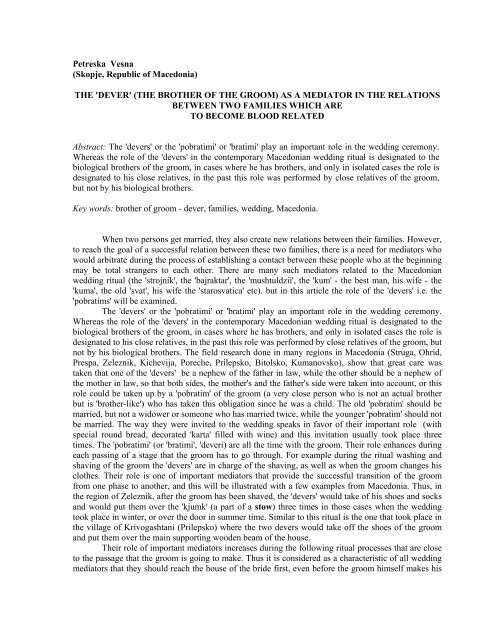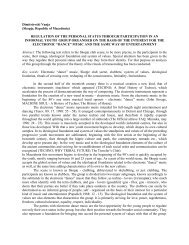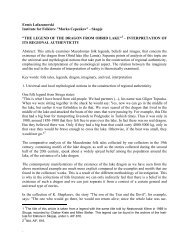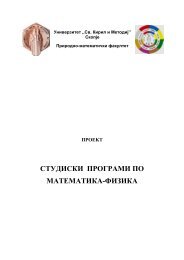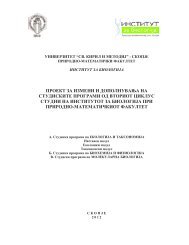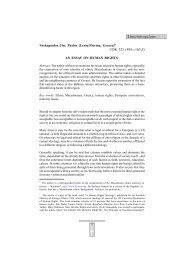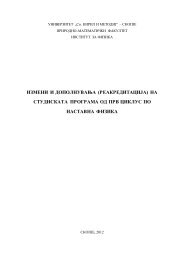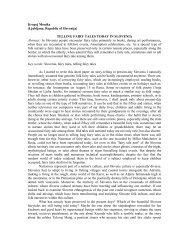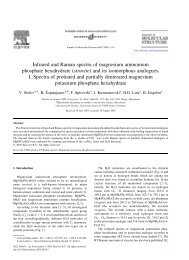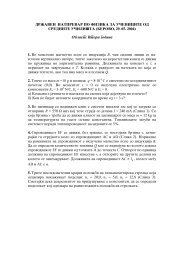Petreska Vesna (Skopje, Republic of Macedonia) THE 'DEVER ...
Petreska Vesna (Skopje, Republic of Macedonia) THE 'DEVER ...
Petreska Vesna (Skopje, Republic of Macedonia) THE 'DEVER ...
Create successful ePaper yourself
Turn your PDF publications into a flip-book with our unique Google optimized e-Paper software.
<strong>Petreska</strong> <strong>Vesna</strong>(<strong>Skopje</strong>, <strong>Republic</strong> <strong>of</strong> <strong>Macedonia</strong>)<strong>THE</strong> <strong>'DEVER</strong>' (<strong>THE</strong> BRO<strong>THE</strong>R OF <strong>THE</strong> GROOM) AS A MEDIATOR IN <strong>THE</strong> RELATIONSBETWEEN TWO FAMILIES WHICH ARETO BECOME BLOOD RELATEDAbstract: The 'devers' or the 'pobratimi' or 'bratimi' play an important role in the wedding ceremony.Whereas the role <strong>of</strong> the 'devers' in the contemporary <strong>Macedonia</strong>n wedding ritual is designated to thebiological brothers <strong>of</strong> the groom, in cases where he has brothers, and only in isolated cases the role isdesignated to his close relatives, in the past this role was performed by close relatives <strong>of</strong> the groom,but not by his biological brothers.Key words: brother <strong>of</strong> groom - dever, families, wedding, <strong>Macedonia</strong>.When two persons get married, they also create new relations between their families. However,to reach the goal <strong>of</strong> a successful relation between these two families, there is a need for mediators whowould arbitrate during the process <strong>of</strong> establishing a contact between these people who at the beginningmay be total strangers to each other. There are many such mediators related to the <strong>Macedonia</strong>nwedding ritual (the 'strojnik', the 'bajraktar', the 'mushtuldzii', the 'kum' - the best man, his wife - the'kuma', the old 'svat', his wife the 'starosvatica' etc). but in this article the role <strong>of</strong> the 'devers' i.e. the'pobratims' will be examined.The 'devers' or the 'pobratimi' or 'bratimi' play an important role in the wedding ceremony.Whereas the role <strong>of</strong> the 'devers' in the contemporary <strong>Macedonia</strong>n wedding ritual is designated to thebiological brothers <strong>of</strong> the groom, in cases where he has brothers, and only in isolated cases the role isdesignated to his close relatives, in the past this role was performed by close relatives <strong>of</strong> the groom, butnot by his biological brothers. The field research done in many regions in <strong>Macedonia</strong> (Struga, Ohrid,Prespa, Zeleznik, Kichevija, Poreche, Prilepsko, Bitolsko, Kumanovsko), show that great care wastaken that one <strong>of</strong> the 'devers' be a nephew <strong>of</strong> the father in law, while the other should be a nephew <strong>of</strong>the mother in law, so that both sides, the mother's and the father's side were taken into account, or thisrole could be taken up by a 'pobratim' <strong>of</strong> the groom (a very close person who is not an actual brotherbut is 'brother-like') who has taken this obligation since he was a child. The old 'pobratim' should bemarried, but not a widower or someone who has married twice, while the younger 'pobratim' should notbe married. The way they were invited to the wedding speaks in favor <strong>of</strong> their important role (withspecial round bread, decorated 'karta' filled with wine) and this invitation usually took place threetimes. The 'pobratimi' (or 'bratimi', 'deveri) are all the time with the groom. Their role enhances duringeach passing <strong>of</strong> a stage that the groom has to go through. For example during the ritual washing andshaving <strong>of</strong> the groom the 'devers' are in charge <strong>of</strong> the shaving, as well as when the groom changes hisclothes. Their role is one <strong>of</strong> important mediators that provide the successful transition <strong>of</strong> the groomfrom one phase to another, and this will be illustrated with a few examples from <strong>Macedonia</strong>. Thus, inthe region <strong>of</strong> Zeleznik, after the groom has been shaved, the 'devers' would take <strong>of</strong> his shoes and socksand would put them over the 'kjumk' (a part <strong>of</strong> a stow) three times in those cases when the weddingtook place in winter, or over the door in summer time. Similar to this ritual is the one that took place inthe village <strong>of</strong> Krivogashtani (Prilepsko) where the two devers would take <strong>of</strong>f the shoes <strong>of</strong> the groomand put them over the main supporting wooden beam <strong>of</strong> the house.Their role <strong>of</strong> important mediators increases during the following ritual processes that are closeto the passage that the groom is going to make. Thus it is considered as a characteristic <strong>of</strong> all weddingmediators that they should reach the house <strong>of</strong> the bride first, even before the groom himself makes his
appearance (1995: A. Zadrozinjska, 142). In this context we can mention the ritual <strong>of</strong> taking away thebride when they are usually standing close to the groom, then the ritual <strong>of</strong> arriving at the bride's housewhen the 'pobratimi' are sitting beside the groom and in many cases advising him on what he should do(especially when it comes to the older 'dever'), after the ritual fight between the groom and the shura -the brother <strong>of</strong> the bride. The 'shura' is not only giving gifts to the groom, but also to the 'pobratimi',while the mother <strong>of</strong> the bride, when greeting her daughter who is leaving the house, also greets thegroom and also the 'pobratimi'. The 'bratimi' are the ones who are present during the ritual'deverisuvanje na nevestata' when the are giving their presents to the bride (the shoes and the wreath).The shoes <strong>of</strong> the bride are put on by the older dever. The fact that the shoes are given to the bride bythe dever, as well as some customs that can be found in the traditions <strong>of</strong> other Slav nations where thebride has to sleep with the dever, the old svat or some other male svat for one or two nights, is related,according to some old research, to the time <strong>of</strong> the passage from a matrilocal to a patrilocal marriage.The tendency <strong>of</strong> this passage included the custom according to which the male relatives <strong>of</strong> the groomhave the right to sleep with his bride on the first night (1956: Kulishic, 228-234). The main objectionto such research is that they can not explain why the bride in some cases sleeps with her mother in lawor with a child. According to E. Gasparini, this custom is related to the well known custom <strong>of</strong>postponement <strong>of</strong> the consumption <strong>of</strong> the marriage (1956: Kulishic, 232, quoted from E. Gasparini,Nozze, societa e abitazione degli antichi Slavi, Instituto univ. di Ca Foscari, Venezia, p. 165-168). Thelatest research agrees with this, since the first night, as a boundary one, is full <strong>of</strong> suspense and dangers(1993: B. Jovanovic, 150-151). The custom according to which the bride sleeps with the mother in lawor some other female person, could reflect the tendency <strong>of</strong> prohibition <strong>of</strong> the relation between personswho are blood related, but at the same time, the symbolic way in which the bride is close to her newhome and the relatives <strong>of</strong> her husband (1956: Kulishic, 234); other authors think that this is done inorder to deceive evil creatures (1984: T. Dzordzevic, book 3, 337). Without going into the genesis <strong>of</strong>the custom, we would only like to stress upon the symbolic role <strong>of</strong> the shoes. The shoes are a symbol<strong>of</strong> the ownership right, the travelling to the world <strong>of</strong> the dead but also in all directions, a pro<strong>of</strong> <strong>of</strong>identity, the biological coming <strong>of</strong> age (The dictionary <strong>of</strong> symbols, under: shoes, 1986: D. Kuper,shoes). Presenting shoes to the bride at the wedding means showing the authority and power <strong>of</strong> thegroom regarding the bride, as well as the fact that she becomes his property. This is connected to M.Mausse's opinion that giving a present means establishing a hierarchical relation, through whichsuperiority is shown especially if the other person is not returning the present (1982: M. Mausse, II,207). The symbolism <strong>of</strong> the shoes which is related to the world <strong>of</strong> the dead, as well as the symbol <strong>of</strong> apassenger, is a western one, as in the case <strong>of</strong> the custom where shoes or boots are put near the fire placethe night before Christmas (Dictionary <strong>of</strong> symbols, shoe). Since the main idea <strong>of</strong> all passage rites isvisiting the world <strong>of</strong> the dead and being born again, this symbols fits here as well, since the bride, bymarrying, leaves her maiden life and enters a new life. This maybe the reason why in all passage ritesconnected to the life cycle shoes play such a prominent role, like making cookies in form <strong>of</strong> feet for achild that has just started walking, putting new shoes on a deceased person etc. The symbol <strong>of</strong> identityis well expressed in the story <strong>of</strong> Cinderella, "the girl whose feet match the shoe will be the prince'swife". Some scientist, mostly psychiatrists have seen in this symbol <strong>of</strong> identity as a symbol <strong>of</strong> fertilityor just a symbol <strong>of</strong> sexual desires that the foot inspires. Thus, the foot is a phallic symbol, while shoessymbolize the vagina (Dictionary <strong>of</strong> symbols, under: shoe, foot, 1979: B. Betelhajm, 292-295). Thepsychoanalysts consider the exchange <strong>of</strong> the rings between the bride and the groom at their wedding assomething similar to the above mentioned (1979: B. Betelhajm, 295). However, even in the case <strong>of</strong> ourwedding ritual, the symbolism <strong>of</strong> the feet and the shoes are connected to the biological maturity <strong>of</strong> thebride as well as <strong>of</strong> the groom. The symbolic role <strong>of</strong> the feet and the shoes emerges from their contactwith the ground, i.e. the relationship with the Earth's fertility (1996 : Lj. Radenkovic, 19, 21). Thisrelation to the fertility is stressed even more when one bares in mind that the shoes are put on by theolder dever, who is married, i.e. who has already a status <strong>of</strong> a person involved in fertility, that is, whohas been in touch with the unknown, the underworld, since according to the folk notions fertility
depends on these forces. А related ritual to this data is the one when the door <strong>of</strong> the bride's room ispushed by the dever, since the doors fall under the system <strong>of</strong> genital symbolism (for example the keyand the key hole), while opening the door during the wedding to some extent symbolizes thedeflowering <strong>of</strong> the bride (1983 : A. Baburin, 13-139). Pro<strong>of</strong> <strong>of</strong> such a statement is found in the results<strong>of</strong> O. Frajdenberg's research (Poetica sjuzheta i zhanra, St. Petersburg, 1936, r. 211) that thinks that inthe agricultural period the doors have symbolized the mother's womb and the vulva. At the same timein the frames <strong>of</strong> the folklore the female genital organ is known as a 'door'.The role <strong>of</strong> the devers is also visible during the bride's exit from her house and the rituals thatfollow when she enters her new one, until the moment <strong>of</strong> her complete acceptance in the new family.Thus, following the moment when the brothers <strong>of</strong> the bride take her out <strong>of</strong> the house and follow her tothe church or half the way to the church, the devers take over. When the bride and the groom entertheir new house, the 'pobratims' put them into a 'jarem' (a yoke) which symbolizes that they bothshould bare the burden <strong>of</strong> the mutual life that lies ahead. They are present during the process <strong>of</strong>instructing the couple, especially the older dever who in the region <strong>of</strong> Kumanovo is known as the"mladozenjski momak' (the groom's friend), who has already gone through that ritual and who givesinstructions to the groom. In this case the older dever is introducing the groom into the circle <strong>of</strong> themarried man, so the goal is that he gets well accepted after the 'job' is successfully done. This is themoment when the groom is proving himself to be a mature man.The older dever reminds the young couple during the night <strong>of</strong> their obligation, and he is theone who should wake them up in the morning. The groom, together with the 'pobratims' and the musicplayers, is the one who informs the parents <strong>of</strong> the bride regarding her 'honesty'. This is the reason whywe can agree with A. Zadrozinjska who says that during all wedding rituals the 'pobratims' canrepresent the groom when they enter the ritual processions, together with the guests, but they do notrepresent him in those rituals that mark the individual initiation <strong>of</strong> the groom like the "shaving <strong>of</strong> thegroom", his washing, travelling towards the bride. Thus they are his ritual doubles that take upon hisrights and obligations (1995 : A. Zadrozinjska, 141).At the time when the young couple is performing their martial duty, the dever or otherparticipant at the wedding is trying to overhear standing at the door what is happening inside the room.According to popular belief, this is done so that the children <strong>of</strong> the couple would not be deaf. Thiscustom is probably a result <strong>of</strong> the function that the voice had in the history <strong>of</strong> culture. Thus, in thecosmogony myths the voice was at the beginning <strong>of</strong> the creation <strong>of</strong> the cosmos, since the light and thevoice are the opposite <strong>of</strong> the darkness and the silence. The voice and the light are characteristic <strong>of</strong> thehuman and this world, while the darkness and the silence are representing the wild and the underworld(1996 : Lj. Radenkovic, 27). This is why the goal <strong>of</strong> some <strong>of</strong> the ritual activities that involve the youngcouple is to make them speak. In ritual terms the performing <strong>of</strong> their duty is followed by suspense,entering the underworld, and in these circumstances the moment <strong>of</strong> overhearing, <strong>of</strong> hearing a voice,should provide them with a successful entry into the human and the realm <strong>of</strong> this world, since the deveror some other person that overhears had the role <strong>of</strong> 'guardians' <strong>of</strong> the border between the wild and thesocial space, and they are enemies <strong>of</strong> the impure forces (1996 : Lj. Radenkovic, 40). The ritual practicethat was done in many regions in <strong>Macedonia</strong> speak in favor <strong>of</strong> this opposition couple nature/culture.Namely, after the bride has been taken to the fireplace, the dever would take her and guide her to theroom where she should sleep with the groom. The relation nature/culture is strengthened by the factthat in many cases the young couple slept in the 'keral' (a part <strong>of</strong> the household where the wheat waskept). This opposition can be traced also in the frames <strong>of</strong> the ritual when the bride is guided from thegarden and into the house, towards the central parts <strong>of</strong> the house (the fireplace and the place where thebread was produced and the flour kept), and put into the 'keral' where she sleeps with the groom. Sheexits this space the next morning, after the female territory was conquered by the groom, or at verticallevel, if one bares in mind the fact that in the past the couple slept few years or some time in separatedpremises, that is together with the animals, then this opposition nature/culture denotes that the
complete entrance into the human world is done only after the couple proved to be able to produceprogeny - only after their child is born.The acceptance <strong>of</strong> the bride into the new community happens when her 'honesty' is announced,that in most cases is done by breaking a barrel or shooting a gun, and in many cases this ritual iscarried out by the devers. In Kumanovsko, for example, the honesty <strong>of</strong> the bride was announced bybreaking a plate by the 'mladozenski momok' who by this ritual was calling upon the mother in law tojoin the celebration (2000 : V. <strong>Petreska</strong>, 351).The dever's role <strong>of</strong> a mediator is illustrated in the best way by the ritual that was done inMariovo, when the mother in law is given presents by the bride. During this procedure, the dever is'strangling the mother in law with his shirt', so that he could get a higher amount <strong>of</strong> money, since hehas provided a bride for the family. The mother in law in order to avoid giving money is saying: "Ihave given everything that I owned to her, I have given to her the 'kacija', the 'crepni', the 'vrshnik', the'furka', the 'igli', the 'nokvi', the 'bukar', the 'sito' (small items <strong>of</strong> the household, used in the process <strong>of</strong>bread making or other house work done by females). Most importantly I have given her a young bullwith one horn" (1962: M. Risteski, V, 40), meaning her son, which makes everyone laugh. Their role<strong>of</strong> mediators, as well as their role in the ritual <strong>of</strong> the final separation <strong>of</strong> the bride from her family, isvery well presented in the ritual that was done in the area <strong>of</strong> Kumanovo. The mother <strong>of</strong> the bride wouldbe informed about the honesty <strong>of</strong> her daughter by sending her a sweet decorated bread, sweet brandyand the bride would send basil bouquets for all girls in the village. The ones who are carrying thebouquets, the bread and the brandy to the mother <strong>of</strong> the bride are called 'deveri', 'kitkari' (the village <strong>of</strong>Orashac) and 'svekri' (village <strong>of</strong> Dovezence). Tuesday morning the sister <strong>of</strong> the bride would go out inthe 'swine centre <strong>of</strong> the village' where the swine eat, and would distribute the bouquets that the bridesent to the girls (2000 : V. <strong>Petreska</strong>, 351-352). This can be connected to the demonic characteristics <strong>of</strong>the swine, that is to its relation to the underworld and the cult <strong>of</strong> fertility. Another example is when thegirls before some holidays (like St. George or New Year) perform magic customs that involve theswine, so that they can get married. The relation <strong>of</strong> the swine to the cult <strong>of</strong> fertility is also shown whenthe Christmas ham is taken into account, ham according to which the prosperity <strong>of</strong> the family as well asthe success <strong>of</strong> the agricultural and shepherd's activities was foreseen (1970 : CMP, under: the pig andthe Christmas ham). A song was sang to the devers at this occasion:Aj sozdravje dva ruchna deveraAj sozdravje dva ruchna deveraAj sozdravje dva ruchna kitkara / ijDa nosite mnogo zdravo-zivoDa nosite na nashata sestra / ijDa ne zali ona da ne placheDa ne zali ona da ne plache / ijKad kje idemo na sharena cheshmanjojni stomni mi gi nosimo / ijKad kje metemo shiroki dvorovis'njonma metla mi kje gi metemo / ij(2000: <strong>Vesna</strong> <strong>Petreska</strong>, 352)Goodbye two deversGoodbye two deversGoodbye two 'kitkaras' /ijBring good wishesto our sister / ijSo that she is not sad,so that she does not weep /ij
When we shall go to bring waterwe shall bring her buckets too /ijWhen we shall sweep the big yardswe shall do it with her broom /ijThe mediator role that the devers have during the separation <strong>of</strong> the bride from her family andher acceptance to the new family (and all its members, including the devers) as a part <strong>of</strong> the family, canbe seen through the terms which she uses to address them. The bride has to use the terms 'brothers' torefer to the brothers <strong>of</strong> the groom, although they are being 'devers' to her. Apart from this being aneveryday routine, we can trace this situation in the folk songs, where we can notice that this is a part <strong>of</strong>the 'training' <strong>of</strong> the bride by her family so that she can receive a good reputation in the new one.Referring to the 'devers' as 'brothers' is part <strong>of</strong> the training, although these are not biological brothers<strong>of</strong> the bride - "'he is not a brother/but you should say 'brother'".According to everything that was already said, one could notice the mediator role <strong>of</strong> the deversthat enhances during each new passage and stops when the wedding ritual ends, when their mediatoryrole is fulfilled - connecting two persons and two families.Notes:Shpiro Kulishic, Tragovi arhaichne porodice u svadbenim obichajima Crne Gore i Boke Kotorske.GZM u Sarajevu, Istorija i etnografija, nova serija, sv. XI, Sarajevo, 1956, pg. 228-234.Bojan Jovanovic, Magija srpskih obreda, Svetovi, Novi Sad, 1993.Tihomir Dzordzevic, "Tovijine noci" in: Nash narodni zivot, 3, Beograd, 1984, pg. 337.J. Chevalier & A. Gheerbrant, Rjechnik simbola. Motivi, sni, obichaji, geste, oblici, likovi, boje,brojevi. Nakladni zavod MH, Zagreb.Dz. K. Kuper, Ilustrovana enciklopedija tradicionalnih simbola. Prosveta - Nolit, Beograd-Ljubljana,1986.Marsel Mos, "Ogled o daru. Oblik i smisao razmene u arhaichnim drushtvima", in: Socijalnaantropologija II, Biblioteka XX vek, 53/2, Prosveta, Beograd, 1982.Bruno Betelhajm, Znachenje bajki. Biblioteka Zenit, Beograd, 1979.Ljubinko Radenkovic, Simbolika sveta u narodnoj magiji juznih Slovena. Prosveta, Nish,Balkanoloshki institut SANU, Beograd, Posebna izdanja, knj. 67, Biblioteka Slovenski svet, Nish,1996.A.K. Bajburin, Zhilishte v obrjadah i predstavlenijah Vostochnìh Slavjan. ANSSSR, Institut Etnografiiim. N.N. Mikluho-Maklaja, Leningradskoe otdelenie, "Nauka", Leningrad, 1983.<strong>Vesna</strong> <strong>Petreska</strong>, Semejniot obreden kompleks vo Kumanovo i Kumanovsko. Folklorot vo Kumanovo iKumanovsko. Institut za folklor "Marko Cepenkov" - <strong>Skopje</strong>, Centar za kultura "TrajkoProkopiev", Kumanovo, Kumanovo, 2000.Milan Risteski, "Selska svadba" V, vo: Stremez, Spisanie za literaturni, kulturni i opshtestveniprashawa, god. VIII, <strong>Skopje</strong>, 1962.
SMR - Sh. Kulishic, P. Z. Petrovic, N. Pantelic, Srpski mitoloshki rechnik, Nolit, Beograd, 1970.


